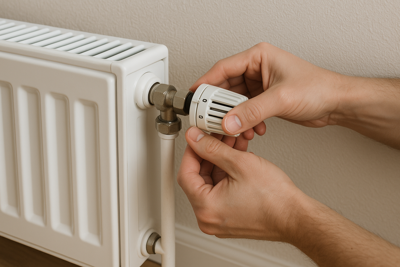Despite being a staple in nearly every British home, the heating system remains one of the most misunderstood features of modern living. Over time, various misconceptions have circulated, often leading to higher energy bills, wasted heat, and unnecessary maintenance.
Understanding how your heating truly works helps you make smarter, more efficient choices that enhance comfort and reduce waste. Let's uncover the truth behind common radiator myths and see how small changes can make a big difference to your home's warmth and efficiency.
Myth #1: Turning Radiators Off Saves Energy

It seems logical to turn your heating off completely in rooms you're not using, but this can actually cause uneven heating throughout your home. Cold rooms draw warmth from adjoining spaces, forcing your boiler to work harder and longer to maintain the desired temperature elsewhere.
The Fix: A better alternative is to use thermostatic radiator valves (TRVs). These let you adjust temperatures in individual rooms without shutting the system down entirely. For even smarter control, consider a zoned heating system to manage multiple areas independently, saving energy while keeping comfort consistent.
Myth #2: Radiators Heat the Air Directly
Many people assume a heating unit warms the air simply by touching it, but they primarily work through convection. Warm air rises from the unit, circulates through the room, and pushes cooler air downwards to be reheated.
The Fix: Because of this, placement matters. Avoid blocking your radiator with large furniture or heavy curtains, as these trap warm air and prevent it from circulating effectively. Ensuring proper airflow improves both performance and comfort.
Myth #3: All Radiators Deliver the Same Efficiency
Not all heating systems are created equal. The material, design, and water content all influence how effectively they perform.
Cast Iron models retain heat for long periods, making them ideal for traditional homes.
Aluminum column radiators heat up and cool down quickly, offering excellent energy responsiveness.
Steel options balance durability with design flexibility.
The Fix: Modern low-water-content designs, like those available from brands such as HotRadiators, are particularly efficient, using less energy to achieve the same warmth. Investing in high-quality systems can deliver long-term savings and superior heat control.
Myth #4: Bigger Radiators Always Mean More Heat
Size does not always equal strength. The amount of heat a unit produces depends on its BTU (British Thermal Unit) rating, not its physical dimensions. Choosing a model that’s too large for a room results in energy waste, while one that’s too small may struggle to maintain comfort.
The Fix: Use a BTU calculator or consult a heating professional to find the ideal output for your space. It’s the surest way to achieve efficient, even warmth.
Myth #5: You Don’t Need to Bleed Radiators Often
Ignoring regular bleeding is one of the easiest ways to lose heating efficiency. Trapped air prevents hot water from circulating properly, leading to cold spots and poor performance.
The Fix: You should bleed your system at least once before winter and again if you notice gurgling noises or uneven heat. This simple maintenance task ensures consistent warmth and helps your system operate at peak efficiency.
Myth #6: Radiator Covers Always Block Heat
While poorly designed covers can trap warmth, well-built enclosures are both stylish and functional. When made from heat-friendly materials and fitted with ventilation gaps, they allow hot air to circulate freely while adding safety and elegance to your space.
The Fix: For family homes, covers also reduce burn risks and can double as practical shelving solutions, proving that style and performance can coexist beautifully.
Myth #7: Electric Radiators Are Too Expensive to Run
Older models were indeed inefficient, but today's smart electric heating systems are a completely different story. Equipped with eco-modes, programmable thermostats, and precise timers, they deliver targeted heat exactly when and where you need it.
The Fix: Many modern models integrate with smart home platforms such as Alexa or Google Home, giving you complete control from your phone. With rising energy awareness, modern electric systems have become a viable and cost-effective option for many households.
Quick Tips to Maximize Your Heating Efficiency
Want to feel warmer without ramping up the boiler? A few simple changes can make a huge difference:
Use Reflectors: Install heat reflectors behind radiators on external walls to direct warmth back into the room.
Clear the Space: Keep furniture and heavy drapes well away to maximize airflow.
Clean Regularly: Dust build-up reduces heat transfer. A quick clean on and behind the radiator improves performance.
Check Valves: Ensure thermostatic valves and controls work properly for balanced warmth.
Schedule Maintenance: A yearly inspection by a professional ensures your system runs safely and efficiently.
Don’t Fall for the Myths, Heat Smarter
By separating fact from fiction, homeowners can cut their energy bills, extend their system's lifespan, and create consistent comfort across every room. Modern heating solutions such as those from HotRadiators combine smart technology with stylish design, offering the perfect balance of performance and aesthetics.


(0) comments
We welcome your comments
Log In
Post a comment as Guest
Keep it Clean. Please avoid obscene, vulgar, lewd, racist or sexually-oriented language.
PLEASE TURN OFF YOUR CAPS LOCK.
Don't Threaten. Threats of harming another person will not be tolerated.
Be Truthful. Don't knowingly lie about anyone or anything.
Be Nice. No racism, sexism or any sort of -ism that is degrading to another person.
Be Proactive. Use the 'Report' link on each comment to let us know of abusive posts.
Share with Us. We'd love to hear eyewitness accounts, the history behind an article.